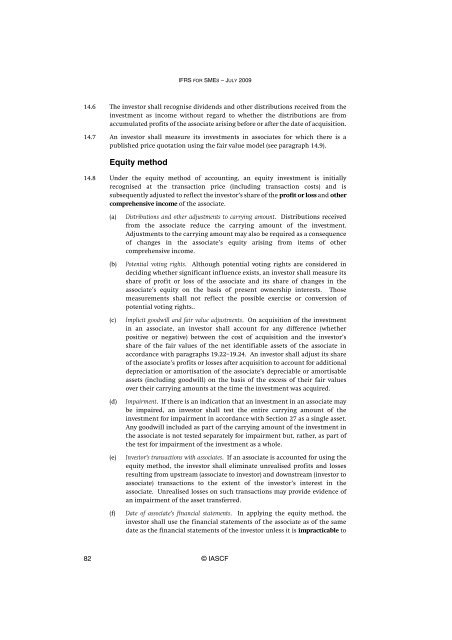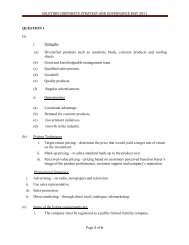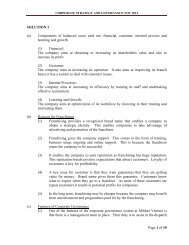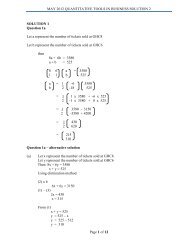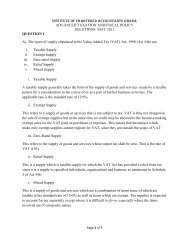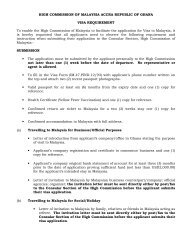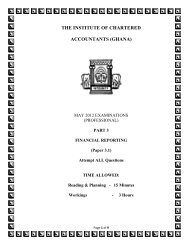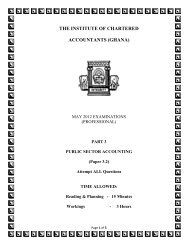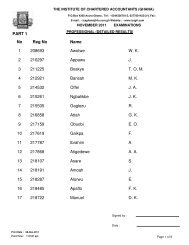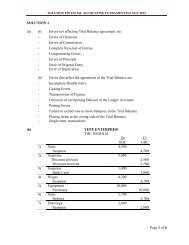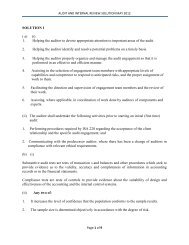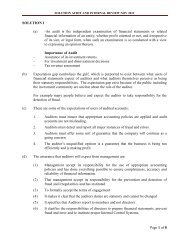(IFRS) for Small and Medium-sized Entities (SMEs)
(IFRS) for Small and Medium-sized Entities (SMEs)
(IFRS) for Small and Medium-sized Entities (SMEs)
Create successful ePaper yourself
Turn your PDF publications into a flip-book with our unique Google optimized e-Paper software.
<strong>IFRS</strong> FOR SMES – JULY 200914.6 The investor shall recognise dividends <strong>and</strong> other distributions received from theinvestment as income without regard to whether the distributions are fromaccumulated profits of the associate arising be<strong>for</strong>e or after the date of acquisition.14.7 An investor shall measure its investments in associates <strong>for</strong> which there is apublished price quotation using the fair value model (see paragraph 14.9).Equity method14.8 Under the equity method of accounting, an equity investment is initiallyrecognised at the transaction price (including transaction costs) <strong>and</strong> issubsequently adjusted to reflect the investor’s share of the profit or loss <strong>and</strong> othercomprehensive income of the associate.(a)(b)(c)(d)(e)(f)Distributions <strong>and</strong> other adjustments to carrying amount. Distributions receivedfrom the associate reduce the carrying amount of the investment.Adjustments to the carrying amount may also be required as a consequenceof changes in the associate’s equity arising from items of othercomprehensive income.Potential voting rights. Although potential voting rights are considered indeciding whether significant influence exists, an investor shall measure itsshare of profit or loss of the associate <strong>and</strong> its share of changes in theassociate’s equity on the basis of present ownership interests. Thosemeasurements shall not reflect the possible exercise or conversion ofpotential voting rights..Implicit goodwill <strong>and</strong> fair value adjustments. On acquisition of the investmentin an associate, an investor shall account <strong>for</strong> any difference (whetherpositive or negative) between the cost of acquisition <strong>and</strong> the investor’sshare of the fair values of the net identifiable assets of the associate inaccordance with paragraphs 19.22–19.24. An investor shall adjust its shareof the associate’s profits or losses after acquisition to account <strong>for</strong> additionaldepreciation or amortisation of the associate’s depreciable or amortisableassets (including goodwill) on the basis of the excess of their fair valuesover their carrying amounts at the time the investment was acquired.Impairment. If there is an indication that an investment in an associate maybe impaired, an investor shall test the entire carrying amount of theinvestment <strong>for</strong> impairment in accordance with Section 27 as a single asset.Any goodwill included as part of the carrying amount of the investment inthe associate is not tested separately <strong>for</strong> impairment but, rather, as part ofthe test <strong>for</strong> impairment of the investment as a whole.Investor’s transactions with associates. If an associate is accounted <strong>for</strong> using theequity method, the investor shall eliminate unrealised profits <strong>and</strong> lossesresulting from upstream (associate to investor) <strong>and</strong> downstream (investor toassociate) transactions to the extent of the investor’s interest in theassociate. Unrealised losses on such transactions may provide evidence ofan impairment of the asset transferred.Date of associate’s financial statements. In applying the equity method, theinvestor shall use the financial statements of the associate as of the samedate as the financial statements of the investor unless it is impracticable to82 © IASCF


